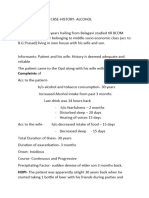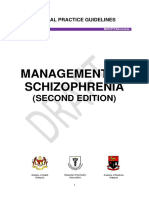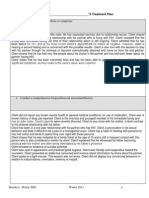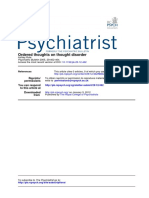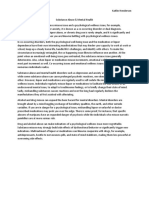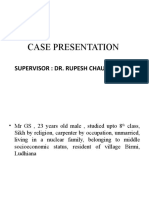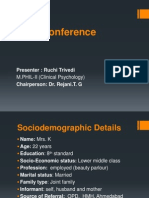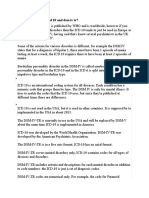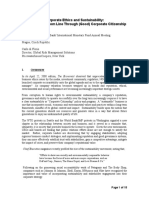CAGE Questionnaire For Alcohol Misuse
CAGE Questionnaire For Alcohol Misuse
Uploaded by
Jeremy BergerCopyright:
Available Formats
CAGE Questionnaire For Alcohol Misuse
CAGE Questionnaire For Alcohol Misuse
Uploaded by
Jeremy BergerOriginal Title
Copyright
Available Formats
Share this document
Did you find this document useful?
Is this content inappropriate?
Copyright:
Available Formats
CAGE Questionnaire For Alcohol Misuse
CAGE Questionnaire For Alcohol Misuse
Uploaded by
Jeremy BergerCopyright:
Available Formats
REVIEW ARTICLE
The CAGE Questionnaire for Alcohol Misuse: A Review of Reliability and Validity Studies
Shayesta Dhalla, MD, MHSc Jacek A. Kopec, MD, PhD Department of Health Care and Epidemiology, University of British Columbia, Vancouver, Canada
Manuscript submitted 5th August, 2006 Manuscript accepted 26th October, 2006 Clin Invest Med 2007; 30 (1): 33-41.
Abstract
Purpose: To review the reliability and validity of the CAGE questionnaire across different patient populations and discuss its role in the detection of alcohol-related problems. Methods: The Cochrane Database for Systematic Reviews, Medline, Embase, and Psychinfo were searched. No systematic reviews were found on the Cochrane Database. Search of the other databases yielded one systematic review and one meta-analysis, on different aspects of CAGE. Three articles on reliability and 16 on validity of CAGE were found and used. Studies generally yielded Level II evidence. Results: CAGE has demonstrated high test-retest reliability (0.80-0.95), and adequate correlations (0.48-0.70) with other screening instruments. The questionnaire is a valid tool for detecting alcohol abuse and dependence in medical and surgical inpatients, ambulatory medical patients, and psychiatric inpatients (average sensitivity 0.71, specicity 0.90). Its performance in primary care patients has been varied, while it has not performed well in white women, prenatal women, and college students. Furthermore, it is not an appropriate screening test for less severe forms of drinking. Conclusions: CAGE is short, feasible to use, and easily applied in clinical practice. However, users should be aware of its limitations when interpreting the results. A positive screen should be followed by a proper diagnostic evaluation using standard clinical criteria.
Alcohol misuse constitutes an important public health problem. Among patients seen by primary care physicians, 10%-36% suffer from alcohol abuse or dependence1. Alcohol misuse can lead to social, workrelated, or legal problems1,2. In Canada, the alcoholrelated death rate in 1995 was 22.2 per 100,000 person-years overall and 4.0 per 100,000 person-years after excluding injuries3. In the United States in 2002, the death rate (excluding injuries) was 7.0 per 100,000 person-years4. Detection of alcohol misuse through opportunistic screening is important for prevention of alcoholrelated morbidity and mortality5. For example, there may be adverse drug-alcohol interactions when alcohol reaches a certain level6. Detection of alcohol misuse can also make available information that can be important in clinical research studies, particularly in analysis of effect of behavior and in studies of geneenvironment interactions7. In an early stage of alcohol misuse, a simple intervention, such as a brief counseling session delivered by a primary care physician, has proven to be an effective treatment 5,6. A number of screening instruments have been used to detect alcohol misuse 8-10. The CAGE questionnaire is a brief and popular screening instrument used in clinical practice 6. Other common instruments include the Alcohol Use Disorders Identication Test (AUDIT), and Michigan Alco33
2007 CIM
Clin Invest Med Vol 30, no 1, February 2007
Dhalla & Kopec. CAGE Questionnaire
TABLE 1. The National Institute of Alcohol Abuse and Alcoholism Denitions of Heavy Drinking, Hazardous Drinking, Alcohol Abuse, and Dependence Type of drinking Heavy drinking Hazardous drinking Alcohol abuse Denition Men: >14 drinks*/week or >4 drinks/occasion Women: >7 drinks*/week or >3 drinks/occasion Men: Women: 21 drinks/week or 7 drinks/occasion at least 3 times/week 14 drinks/week or 5 drinks/occasion at least 3 times/week
Alcohol dependence (Alcoholism)
1 or more of the following: 1) failure to fulll major role obligations at work, school, or home due to recurrent drinking; 2) recurrent drinking in hazardous conditions (e.g., driving a car, operating machinery); 3) recurrent legal problems due to alcohol 4) current use despite recurrent interpersonal or social problems 3 or more of the following: 1) tolerance, withdrawal symptoms, or drinking to relieve withdrawal 2) impaired control 3) drank more or longer that intended 4) increased time spent drinking or recovering 5) continued use despite recurrent psychological or physical problems
Reference6 *A standard drink contains 0.6 oz. pure alcohol
hol Screening Test (MAST) 6. While the 4-item CAGE is used to detect alcohol abuse and dependence, the 10-item AUDIT can detect less severe forms of drinking. The MAST is a longer instrument, with 24 questions, although two abbreviated versions are available, a 10-question Brief MAST (BMAST) and a 13-question Short MAST (SMAST) 2. In this article we review the psychometric properties of CAGE across different patient populations and discuss its role in the detection of alcohol-related problems. Methods Search strategies We searched the Cochrane Database for Systematic Reviews, Medline (1966 to present), Embase (1980 to present), and Psychinfo using the following search terms: CAGE, CAGE questionnaire, psychiatric status rating scales and alcohol. We retrieved 279 abstracts from Medline, 48 from Embase, and 131 from Psychinfo. Articles were excluded if they were not reliability or validity studies. In addition, articles were included if they met the following inclusion criteria 7: 1) published in a peer-reviewed journal; 2) written in English; 3) reported reliability or validity measures; 4) used a proper gold standard for validity assessment. Additional articles were retrieved from
bibliographic references, and could either be original research articles or review articles. For original articles on reliability, we included all articles that examined test-retest reliability, and those that examined correlation between CAGE and other instruments. The validity criteria used for the inclusion of the studies in our review were the use of the Diagnostic Interview Schedule (DIS) and the Composite International Diagnostic Interview (CIDI). Less commonly, in some studies that we report, selfreport11 or the use of another screening questionnaire, such as the MAST12 were used as the criterion standard. Description of validity measures The National Institute of Alcohol Abuse and Alcoholism (NIAAA) in the US has developed denitions for several types of problem drinking 6 (Table 1). The Diagnostic and Statistical Manual of Mental Disorders, 4th Edition (DSM-IV) and the International Statistical Classication of Diseases, 10th Revision (ICD10) provide guidelines for diagnosis of alcohol use disorder.2 The Diagnostic Interview Schedule (DIS) has an alcohol module which includes 20 questions based on the DSM-IIIR criteria for alcohol use disorders. The Composite International Diagnostic Interview (CIDI) consists of an alcohol section with a se34
2007 CIM
Clin Invest Med Vol 30, no 1, February 2007
Dhalla & Kopec. CAGE Questionnaire
TABLE 2. Reliability Studies of the CAGE Questionnaire Teitelbaum, 200021 Teitelbaum, 200021 Hays, 199522 Hays, 199522 Hodgson, 2003 23 Psychiatric sample, 7-day interval Community sample, 7-day interval Drinking driving treatment program clients, Southern California Drinking driving treatment program clients, Southern California Accident and Emergency department patients in 4 U.K. centres Test-retest correlation Test-retest correlation Correlation with SMAST Correlation with AUDIT Correlation with AUDIT 0.80 0.95 0.70 0.62 0.48
ries of 23 questions based on the DSM-IV criteria.13 The CIDI can be given in written form, although this method is rarely used.14 The DSM does not have criteria for less severe forms of drinking and cannot be used as the gold standard for this problem.6 The instruments described above require large amounts of time and trained personnel for administration. Content and format of CAGE The CAGE questionnaire was developed in 1968 by Ewing .15 The acronym stands for 4 yes/no items constituting the screening test: 1) Have you ever felt that you ought to Cut down on your drinking? 2) Have people Annoyed you by criticizing your drinking? 3) Have you ever felt bad or Guilty about your drinking? 4) Have you ever had a drink rst thing in the morning to steady your nerves or to get rid of a hangover (Eye-opener)? Individual item responses are scored 0 if the person answers no and 1 if the person answers yes. The total score can range from 0 to 4. CAGE can be administered in 30 seconds, is easily memorized 16 and non-intimidating.13 It is often used as an interview but can also be given in written form.17 However, the dichotomous response format of the CAGE can also be relatively insensitive to small differences in alcohol-related problems.6 The recommended cutoff for CAGE is 2 to screen for alcohol abuse or dependence, although a cutoff of 1 has been used in some studies.8 Results No systematic reviews were found on the Cochrane Database. Search of the other databases yielded one 2007 CIM
systematic review and one meta-analysis on different aspects of CAGE. Apart from these, there were a total of 3 articles on reliability, and 16 on validity of CAGE. Cage format Two studies assessed modications in the format of CAGE.12,18 In one study, a version of CAGE with a general introductory statement (Please tell me about your drinking) produced a higher sensitivity than a questionnaire that included a more specic, closeended introductory question (How much do you drink).12 A second study found no inuence of either the wording of the introduction or question sequence on the sensitivity of the instrument.18 Reliability and correlations with other screening tests Reliability refers to consistency or repeatability of scores and is an indicator of random measurement error.19. Coefcients > 0.7 or 0.8 for the above are usually regarded as adequate.20. Test-retest reliability of CAGE (test-retest interval of 7 days) was 0.80 in psychiatric outpatients and 0.95 in a community sample with no psychiatric history, both with alcohol use disorders 21 (Table 2). In a U.S. study among clients of a drinking and driving treatment program, the correlations were 0.62 with AUDIT and 0.70 with SMAST 22 (Table 2). Scores on CAGE correlated 0.48 with the AUDIT in a large community sample in the UK .3 For instrument correlation with other measures, it is more difcult to set standards for adequacy, as the correlations depend on the reliability and validity of the comparator instrument and the similarity of 35
Clin Invest Med Vol 30, no 1, February 2007
Dhalla & Kopec. CAGE Questionnaire
TABLE 3. Validity Studies of the CAGE Questionnaire for Alcohol Abuse/Dependence Source StudyPopulation Cutoff Score Sensitivity Specicity VA hospital psychiat- 2 0.81 0.89 Mayeld,19742, 24 ric inpatients 1 0.90 0.72 2, 25 Bush, 1987 2 0.75 0.96 Medical & orthope1 0.85 0.89 dic inpatients Barry, 199027 Primary care clinics 1 0.39 0.93 Beresford,199028 General hospital 2 0.76 0.94 medical & surgical inpatients Buchsbaum, 19912, 29 Ambulatory medical 2 0.74 0.91 clinic 1 0.89 0.81 Magruder- Habib, General medical Life 2 0.78 0.76 199330 clinic Present 2 1.00 0.61 Present 3 1.00 0.81 31 Chan, 1994 Primary care patients 2 0.91 0.84 Saitz, 199932 Latinos living in U.S. 2 0.80 0.93 30 Aertgeerts, 2000 College freshmen, 1 0.42 0.87 Belgium Fiellin, 20007 (review) Primary care patients 2 0.43-0.94 0.70-0.97 Saremi, 200133 American Indians 2 men 2 women 0.68 0.62 0.93 0.79
Prevalence 39% 20% 30% 27%
PPV 0.82 0.67 0.82 0.62 0.70 0.87
NPV 0.88 0.92 0.94 0.96 0.78 0.91
36% 25%
36% 14%
0.82 0.72 0.52 0.46 0.64 0.80 0.73 0.36
0.86 0.93 0.91 1.00 1.00 0.89 0.90
85% 53%
0.98 0.77
0.34 0.65
PPV = Positive Predictive Value NPV=Negative Predictive Value Bold = Values calculated by authors of this article
the concepts measured. Given that these instruments measure slightly different concepts, the observed correlations are in the expected range. Validity The CAGE was originally validated by Mayeld in a group of 366 psychiatric inpatients 24 (Table 3). Other studies have subsequently assessed the sensitivity, specicity, positive predictive value (PPV), and negative predictive value (NPV) of CAGE as a screening tool for alcohol abuse/dependence 2, 25, 26-33. Positive predictive value is important clinically, as it gives information about those who have disease among those who are screened. In a meta-analysis of 10 studies, for a cutoff 2, the sensitivities were 0.87 in hospital inpatients, 0.71 in primary care patients, and 0.60 in ambulatory medical patients. The specicities were 0.77, 0.91,
and 0.92, and the PPVs were 0.57, 0.74, and 0.82, respectively.9 In Magruber Habibs study of patients attending a general medical clinic, the PPV was only 0.53 for lifetime alcohol abuse / dependence.30 Other studies of hospital and ambulatory patients show acceptable values of sensitivity, specicity, and PPV, although these coefcients in primary care patients are varied. In a large study of college freshmen attending a Catholic University in Belgium, a cutoff 1 yielded a sensitivity of only 0.42, and specicity was 0.87, with a PPV of 0.36.14 College students tend to binge drink and CAGE may not be as useful for detecting this form of alcohol abuse. When the second question of CAGE was replaced with driving under the inuence, sensitivity increased to 0.94 and specicity was 0.89. Most studies, although including women, did not examine sex-based differences of CAGE. A study 36
2007 CIM
Clin Invest Med Vol 30, no 1, February 2007
Dhalla & Kopec. CAGE Questionnaire
among white women in a primary care population yielded a sensitivity of only 0.38.34 CAGE has tended to perform somewhat better in black females.35 It has not performed adequately in prenatal women.2, 26 Sensitivity may be lower in pregnant women and in women in general due to under-reporting, likely due to stigma. Positive predictive values are also lower in women, reecting a much lower prevalence of alcohol misuse in women. In a study examining male and female drinkers that reported having 15 drinks/week, the PPV was 0.46 for men, and only 0.27 for women.34 A review by Fiellin showed CAGE to be superior to AUDIT in terms of screening for alcohol abuse/ dependence in a primary care population.7 Only sensitivities and specicities were reported in this review article. CAGE has also been used to detect heavy or hazardous drinking; however, it was less sensitive and specic than AUDIT in head-to-head comparisons.7 Combining CAGE with other questionnaires Rumpf et al. reported a study in which 2 CAGE questions were combined with 5 MAST questions to
TABLE 4. Validity Studies of Combination Questionnaires Source New Questionnaire Combined * Questionnaire CAGE (2) MAST (5) Study Population General hospital General practice 40 y/o men attending health screening General medical outpatients
screen for alcohol abuse/dependence in general hospital and general practice samples.36 Using the alcohol module of the Schedules for Clinical Assessment in Neuropsychiatry (SCAN) as the gold standard 36,37, this new instrument, called the Luebeck Alcohol Dependence and Abuse Screening test (LAST), demonstrated a higher sensitivity than with the standard CAGE (Table 4). In a study of 40 year-old men attending health screening in a Finnish town, AUDIT questions 1 and 2 (asking about frequency and quantity of use) were combined with CAGE questions 2, 3, and 4 to yield a new instrument that was used to differentiate between moderate drinkers (<140 g/week) and heavy drinkers ( 280 g/week), as determined from self-reported alcohol consumption.11 At a cut-off of 3, the combined questionnaire gave a sensitivity of 0.77 for detecting heavy drinkers, higher than the CAGE sensitivity of 0.47. Using the same cutoff, the specicity was 0.83 compared to a CAGE specicity of 0.87. A study of male general medical outpatients used an augmented version of CAGE, in which the 4 CAGE questions and the question Have you ever had a drinking problem? were followed by AUDIT ques-
Condition Alcohol Abuse/ Dependence
Cutoff Score LAST 2 CAGE 2 LAST 2 CAGE 2 5-Shot 3 CAGE 2
Sensitivity 0.82 0.72 0.63 0.53 0.77 0.47
Specicity 0.91 0.93 0.93 0.93 0.83 0.87
Rumpf,199736 LAST
Seppa,199811
5-Shot
AUDIT (2) CAGE (3)
Heavy Drinking
Bradley,19981 Augmented CAGE
CAGE (4) AUDIT (2)
Heavy Drinking
CAGE 2 AugmentedCAGE 2 AUDIT 8
0.49 0.70 0.57
0.75 0.68 0.92
*see appendix
2007 CIM
Clin Invest Med Vol 30, no 1, February 2007
37
Dhalla & Kopec. CAGE Questionnaire
tions 1 and 2.1 Patients were classied as heavy drinkers if they drank >14 drinks/week in a month, or 5 drinks/day at least monthly using the DSM-IIIR as the gold standard. The sensitivities for CAGE, augmented CAGE, and AUDIT were 0.49, 0.70, 0.57, and the specicities were 0.75, 0.68, and 0.92, respectively.1 Discussion There are a number of different instruments used for screening for alcohol misuse. The CAGE questionnaire has been the most widely used instrument for detecting alcohol abuse / dependence. CAGE has demonstrated high test-retest reliability (0.80-0.95), and adequate correlations with other instruments (0.48-0.70). It also appears to have adequate validity for detecting alcohol abuse/dependence in medical and surgical inpatients, psychiatric inpatients, and ambulatory medical patients. It has not performed well in white women, prenatal women, and college students, and is not recommended as a screening test for heavy or hazardous drinking. There has been one systematic review8 and one diagnostic meta-analysis9 regarding the CAGE questionnaire, although other review articles have been published.6,10 Other opinions have corroborated the above ndings. However, in their overview of screening and diagnosis of alcohol use disorders, Maisto and Saitz state that CAGE 1 can be used to detect hazardous drinking10. In practice, however, it may be best to use AUDIT in this situation 6, 8, 9. Psychometric properties of CAGE in the included studies varied depending on the study population and standards used for validity assessment. Changing the cutoff score from 2 to 1 resulted in greater test sensitivity but lower specicity, as expected. Specicity of a screening test is important, considering the social and legal consequences of false identication of alcohol abuse.33 A cutoff 2 is recommended to detect alcohol abuse or dependence to provide the best combination of sensitivity, specicity, and positive predictive value. Alternative screening questionnaires to CAGE include AUDIT and MAST. AUDIT is currently the
only instrument yielding high sensitivities and specicities for less severe forms of drinking. MAST is too long for routine use in clinical practice and more information is needed on the properties of its abbreviated versions (BMAST and SMAST) in different populations. Limitations There are a number of methodological problems in the studies included in this review. First, the choice of a gold standard may affect the results of validity studies. While most studies used CIDI or DSM-IIIR for this, some studies used other criteria, for example selfreported alcohol consumption.11 Comparisons between studies that use different validity criteria are limited. Second, comparisons between instruments across studies are difcult to interpret due to methodological differences while head-to-head comparisons are relatively rare. Third, bias due to non-response was a potential problem.1 For example, in one study, non-respondents were signicantly more likely to be heavy drinkers and problem drinkers than participants and reported higher scores on the augmented CAGE.1 Fourth, the data may have been inuenced by measurement errors due to social desirability, interviewer bias, question misinterpretation, and use of proxy respondents.1, 20 Adequate training of the interviewers, and computer-based self-reporting can improve quality of the data and should be implemented in future studies.10 Fifth, generalizability of the results to specic patient groups may be limited. In particular, there was lack of sufcient representation of women, persons <18 years of age, and ethnic minorities. Finally, screening for alcohol misuse in the elderly is not addressed in our article, and this topic would require a separate review. Future studies Differences in the psychometric properties of CAGE among different populations need to be further elucidated. It is possible that different screening tests could be used in different groups, for example, based on gender or ethnicity. More studies are needed on combined questionnaires that include CAGE as one 38
2007 CIM
Clin Invest Med Vol 30, no 1, February 2007
Dhalla & Kopec. CAGE Questionnaire
component. Also, the wording of the introduction and the number of response options could be modied to improve the psychometric properties of CAGE. Conclusions Although the CAGE questionnaire can be a useful and valid screening tool, many physicians and other health professionals may be reluctant to apply it.9, 37 Our review has established that CAGE has limitations in certain populations and can be used to screen for only certain types of alcohol misuse problems. However, in general, a wider use of this and other brief questionnaires to screen patients for alcohol-related problems in appropriate circumstances would likely improve the provision of care for such patients. Acknowledgments The authors would like to acknowledge Dr. Kay Teschke, for comments on an earlier version of the manuscript. References
1. Bradley KA, Bush KR, McDonell MB, Malone T, Fihn T. Screening for Problem Drinking, Comparison of CAGE and AUDIT. J Gen Intern Med 1998;13:379-88. 2. Kitchens JM. The Rational Clinical Examination. Does This Patient Have an Alcohol Problem? JAMA 1994;272:1782-7. 3. Canadian Profile: Alcohol, Tobacco, and other Drugs, 1999. Available at: www.ccsa.ca 4. National Vital Statistics Report. 2004;53. Available at : www.cdc.gov/nchs/data/nvsr/nvsr53/nvsr53/nvsr53_0 5acc.pdf 5. Fleming M, Manwell LB. Brief Intervention in Primary Care Settings. A Primary Treatment Method for At-Risk, Problem, and Dependent Drinkers. Alcohol Res Health 1999;23:129-137. 6. Reid MC, Fiellin DA, OConnor PG. Hazardous and Harmful Alcohol Consumption in Primary Care. Arch Intern Med 1999;159:1681-9. 7. Russo D, Purohit V, Foudin L, Salin M. Workshop on Alcohol Use and Health Disparities 2002: A Call to Arms. Alcohol 2004;32:37-43. 8. Fiellin DA, Reid M.Carrington, OConnor PG. Screening for Alcohol Problems in Primary Care: A
Systematic Review. Arch Intern Med 2000;160:1977-89. 9. Aertgeerts B, Buntinx F, Kester A. The Value of the CAGE in Screening for Alcohol Abuse and Alcohol Dependence in General Clinical Populations: A Diagnostic Meta-Analysis. J Clin Epidemiol 2004;57:30-9. 10.Maisto SA, Saitz R. Alcohol Use Disorders: Screening and Diagnosis. Am J Addict 2003; 12:S12-25. 11.Seppa K, Lepisto J, Sillanaukee P. Five-Shot Questionnaire on Heavy Drinking. Alcohol Clin Exp Res 1998;22:1788-91. 12.Steinwig DL, Worth H. Alcoholism: The Keys to the CAGE. Am J Med 1993;94:520-3. 13.Clements R. A Critical Evaluation of Several Alcohol Screening Instruments Using the CIDI-SAM as a Criterion Measure. Alcohol Clin Exp Res 1998;22(5):985-93. 14.Aertgeerts B, Buntix F, Bande-Knops J, Vandermeulen C, Roelants M, Ansoms S, et al. The Value of CAGE, CUGE, and AUDIT in Screening for Alcohol Abuse and Dependence Among College Freshmen. Alcohol Clin Exp Res 2000 ;24:53-7. 15.Ewing JA. Detecting Alcoholism; The Cage Questionnaire. JAMA 1968;252:1905-7. 16.OConnell H, Chin AV, Hamilton F, et al. A Systematic Review of the Utility of Self-Report Alcohol Screening Instruments in the Elderly. Int J Geriatr Psychiatry 2004;19:1074-86. 17.Aertgeerts B, Buntinx F, Fevery J, Ansoms S. Is there a Difference Between CAGE Interviews and Written CAGE Questionnaires? Alcohol Clin Exp Res 2000;24:733-6. 18.Friedmann PD, Saitz R, Gogineni A, Xhang JX, Stein MD. Validation of the Screening Strategy in the NIAAA Physicians Guide to Helping Patients with Alcohol Problems. J Stud Alcohol 2001; 62:234-8. 19.Streiner DL, Norman GR. Health Measurement Scales: A Practical Guide to Their Development and Use. New York: Oxford University Press; 2003; 12652. 20.Nunnally JC, Bernstein IH. Psychometric Theory. New York: McGraw-Hill, Inc.; 1994; 264-5. 21.Teitelbaum LM, Carey KB. Temporal Stability of Alcohol Screening Measures in a Psychiatric Setting. Psychol Addict Behav 2000;14:401-4. 22.Hays RD, Merz JF: Response Burden, Reliability, and Validity of the CAGE, Short MAST, and AUDIT Alcohol Screening Measures. Behav Res Methods Instrum Comput 1995, 27(2):277-280.
2007 CIM
Clin Invest Med Vol 30, no 1, February 2007
39
Dhalla & Kopec. CAGE Questionnaire
23.Hodgson RJ, John B, Abbasi T, et al. Fast Screening for Alcohol Misuse. Addictive Behaviors. 2003;28:1453-63. 24.Mayfield D, McLeod G, Hall P. The CAGE Questionnaire: Validation of a New Alcoholism Screening Instrument. Am J Psychiatry 1974;131:1121-3. 25.Bush B, Shaw S, Cleary, Delbanco TL, Aronson MD. Screening for Alcohol Abuse Using the CAGE Questionnaire. Am J Med 1987;82:231-5. 26.Sokol RJ, Martier SS, Ager JW. The T-ACE Questions: Practical Prenatal Detection of At-Risk Drinking. Am J Obstet Gynecol 1989;160:863-8. 27.Barry KL, Fleming MF. Computerized Administration of Alcoholism Screening Tests in a Primary Care Setting. J Am Board of Fam Pract 1990;3:93-8. 28.Beresford TP, Blow FC, Hill E, Singer K, Lucey MR. Comparison of CAGE Questionnaire and ComputerAssisted Laboratory Profiles in Screening for Covert Alcoholism. Lancet 1990;336:482-5. 29.Buchsbaum DG, Buchanan RG, Centor RM, Schnoll SH, Lawton MJ. Screening for Alcohol Abuse Using CAGE Scores and Likelihood Ratios. Ann Intern Med 1991;115:774-7. 30.Magruber-Habib K, Stevens H, Alling WC. Relative Performance of the MAST, VAST, AND CAGE Versus DSM-III Criteria for Alcohol Dependence. J Clin Epidemiol 1993;46:435-41. 31.Chan AW, Pristach EA, Welte JW. Detection by the CAGE of Alcoholism or Heavy Drinking in Primary Care Outpatients and the General Population. J Subst Abuse 1994;6:123-35. 32.Saitz R, Lepore MF, Sullivan LM, Amaro H., Samet JH. Alcohol Abuse and Dependence in Latinos Living in the United States: Validation of the CAGE Questions. Arch Intern Med 1999;159:718-24. 33.Saremi A, Hanson, RL, Williams DE, et al.: Validity of the CAGE Questionnaire in an American Indian Population. J Stud Alcohol 2001;62:294-300. 34.Bisson J, Nadeau L, Demers A. The Validity of the CAGE Scale to Screen for Heavy Drinking and Drinking Problems in a General Population Survey. Addiction 1999;94(5):715-25. 35.Bradley K, Boyd-Wickizer J, Powell SH, Burman ML. Alcohol Screening Questionnaires in Women: A Critical Review. JAMA 1998;280:166-71. 36.Rumpf HJ, Hapke U, Hill A, Ulrich J. Development of a Screening Questionnaire for the General Hospital and General Practices. Alcohol Clin Exp Res 1997;21(5):894-8. 37.Ustun B, Compton W, Mager D, et al. WHO Study on the Reliability and Validity of the Alcohol and Drug
Use Disorder Instruments: Overview of Methods and Results. Drug Alcohol Depend 1997;47:161-9. 38.Spandorfer JM, Israel Y, Turner BJ. Primary care physicians' views on screening and management of alcohol abuse: inconsistencies with national guidelines. J Fam Pract 1999;48:899-902.
Correspondence to: Shayesta Dhalla, MD, MHSc Department of Health Care and Epidemiology James Mather Building 5804 Fairview Avenue Vancouver, B.C., Canada V6T 1Z3 Tel: 604-822-2772 Fax: 604-822-4994 Email: shayestadhalla@yahoo.com
2007 CIM
Clin Invest Med Vol 30, no 1, February 2007
40
Dhalla & Kopec. CAGE Questionnaire
Appendix CAGE Questions 1. Have you ever felt you ought to cut down on your drinking? 2. Have people annoyed you by criticizing your drinking? 3. Have you ever felt or bad or guilty about your drinking? 4. Have you ever had a drink rst thing in the morning to steady your nerves or get rid of a hangover? Audit Questions 1. How often did you have a drink containing alcohol in the past year? (0) Never (1) Monthly or less (3) 2-4 times/month (4) 2-3 times/week (5) 4 times/week 2. How many drinks containing alcohol did you have on a typical day when you were drinking in the past year? (1) 1 or 2 (2) 3 or 4 (3) 5 or 6 (4) 7 to 9 (5) 10 or more Augmented CAGE: 1. CAGE questions 2. AUDIT questions (1-2) 3. Have you ever had a drinking problem? 5-Shot: 1. AUDIT Questions (1-2) 2. CAGE questions (2-4)
4. Have you ever gotten into trouble at work because of your drinking? 5. Have you ever been told you have liver trouble such as cirrhosis? 6. Have you ever been hospitalized because of your drinking? ** All yes or no questions Question 1 scoring: no Questions 2-6: scoring: yes Two or more points indicative of alcohol dependence or abuse.
**LAST Questionnaire: 1. Are you able to stop drinking when you want to? 2. CAGE Questions (1) and (2) 3. Does any near relative or close friend worry or complain about your drinking?
2007 CIM
Clin Invest Med Vol 30, no 1, February 2007
41
You might also like
- Buy Ebook The American Psychiatric Association Publishing Textbook of Geriatric Psychiatry 6th Edition Not True PDF David C. Steffens Cheap PriceDocument75 pagesBuy Ebook The American Psychiatric Association Publishing Textbook of Geriatric Psychiatry 6th Edition Not True PDF David C. Steffens Cheap Pricedorfemprez100% (3)
- Alcohol Case HistoryDocument10 pagesAlcohol Case Historysusan291No ratings yet
- NURS6035 Guide To Assessment 1 Written Assignment 1 Psychosocial Intervention Theory1-1Document12 pagesNURS6035 Guide To Assessment 1 Written Assignment 1 Psychosocial Intervention Theory1-1Zunaira ArshadNo ratings yet
- Division 190 - Accessibility2007 English Rev0Document37 pagesDivision 190 - Accessibility2007 English Rev0nezajebavajNo ratings yet
- Final Period - Assignment NCM 105Document3 pagesFinal Period - Assignment NCM 105Chester NicoleNo ratings yet
- Bernard Gallagher Cap. 5 Sociology of Mental IllnessDocument16 pagesBernard Gallagher Cap. 5 Sociology of Mental IllnessLaura Cristina100% (1)
- Annotated BibliographyDocument5 pagesAnnotated Bibliographyapi-399404406100% (2)
- Sample Substance Use Conceptualization and Treatment PlanDocument9 pagesSample Substance Use Conceptualization and Treatment PlanNORAZLINA BINTI MOHMAD DALI / UPM100% (2)
- The National Music Artist of The PhilippinesDocument38 pagesThe National Music Artist of The PhilippinesKristel Gail Basilio100% (1)
- SK EssayDocument4 pagesSK EssayZora991No ratings yet
- Schizophrenia Case StudyDocument14 pagesSchizophrenia Case StudyhazaranazbintimohdaslamNo ratings yet
- Case ReportDocument58 pagesCase ReportMahnoor MalikNo ratings yet
- Schizotypal Personality DisorderDocument5 pagesSchizotypal Personality DisorderJoel LenamingNo ratings yet
- Mental Health-Case Study GDocument14 pagesMental Health-Case Study Gapi-545670336No ratings yet
- Case Analysis Assignment: Interpersonal and Social Rhythm TherapyDocument2 pagesCase Analysis Assignment: Interpersonal and Social Rhythm TherapyJoshua RingorNo ratings yet
- Chief ComplaintDocument4 pagesChief ComplaintarohrbacherNo ratings yet
- Psychiatric Interview Professor Safeya Effat: I History Taking 1. Personal DataDocument4 pagesPsychiatric Interview Professor Safeya Effat: I History Taking 1. Personal DataAcha Angel BebexzNo ratings yet
- Psychiatric Mental Health Comprehensive Case StudyDocument12 pagesPsychiatric Mental Health Comprehensive Case Studyapi-603618331No ratings yet
- NRNP PRAC 6635 Comprehensive Psychiatric Evaluation Template 2Document6 pagesNRNP PRAC 6635 Comprehensive Psychiatric Evaluation Template 2superbwriters10No ratings yet
- Comprehensive Case StudyDocument11 pagesComprehensive Case Studyapi-546503916No ratings yet
- Hallucinogen Related DisordersDocument13 pagesHallucinogen Related DisordersHillary BalderasNo ratings yet
- Case No.7 SchizopherniaDocument18 pagesCase No.7 SchizopherniaAlyna QureshiNo ratings yet
- Nimra CasesDocument34 pagesNimra Casesua9985872No ratings yet
- Case Report ScenarioDocument6 pagesCase Report ScenarioIttba RafiqueNo ratings yet
- (MARIJUANA ABUSE) JOYCE'S Final Care StudyDocument67 pages(MARIJUANA ABUSE) JOYCE'S Final Care StudyedmondNo ratings yet
- Comprehensive Case StudyDocument10 pagesComprehensive Case Studyapi-545708059No ratings yet
- Case History, Assessment Process and ReportDocument88 pagesCase History, Assessment Process and ReportBal Krishna TharuNo ratings yet
- Joshua Dodot Case StudyDocument2 pagesJoshua Dodot Case StudyJoshua Ringor100% (1)
- Persistent Depressive Disorder (Dysthymia) - ClinicalKeyDocument13 pagesPersistent Depressive Disorder (Dysthymia) - ClinicalKeyMasithaNo ratings yet
- Barth BulimiaDocument13 pagesBarth BulimiaFernando Mišel PessoaNo ratings yet
- What Is Delusional Disorder?Document2 pagesWhat Is Delusional Disorder?Rizki Muhammad RanandaNo ratings yet
- Psych OutlineDocument4 pagesPsych OutlineSam Raven AndresNo ratings yet
- Forensic AssessmentDocument8 pagesForensic AssessmentSinginintherain1125No ratings yet
- Epidemiology of Mental IllnessDocument12 pagesEpidemiology of Mental Illnessiswarya vellaisamyNo ratings yet
- Milestone StudiesDocument75 pagesMilestone StudiesPriyash JainNo ratings yet
- C7458. The Discussion and Structure of Psychological Assessment and Case FormulationDocument13 pagesC7458. The Discussion and Structure of Psychological Assessment and Case FormulationDavid Moore, PhD CDP100% (2)
- Khadija TariqDocument7 pagesKhadija TariqkhadijjatariqNo ratings yet
- CPG 2021 Management of Schizophrenia (Second Edition) For ReviewersDocument77 pagesCPG 2021 Management of Schizophrenia (Second Edition) For ReviewersKA KABUANNo ratings yet
- Cns 6161 Treatment Plan - WalterDocument7 pagesCns 6161 Treatment Plan - Walterapi-263972200No ratings yet
- Intake AssessmentDocument2 pagesIntake Assessmentyourzxtruly0% (1)
- Case Study On Adhd FinalDocument33 pagesCase Study On Adhd FinalafrnbrahNo ratings yet
- Thought DisordersDocument4 pagesThought Disordersgnanam ambalavananNo ratings yet
- Substance Abuse & Mental HealthDocument1 pageSubstance Abuse & Mental Healthkaitlin100% (1)
- Comparison Bet ICD & DSM PDFDocument18 pagesComparison Bet ICD & DSM PDFTiffany SyNo ratings yet
- A Case of Social PhobiaDocument3 pagesA Case of Social PhobiaFaRaz MemOnNo ratings yet
- Case Presentation - Bpad GsDocument10 pagesCase Presentation - Bpad GsAarti GuptaNo ratings yet
- Chapter 1 Developmental PsychopathologyDocument30 pagesChapter 1 Developmental PsychopathologyLAVANYA M PSYCHOLOGY-COUNSELLINGNo ratings yet
- Case ConferenceDocument32 pagesCase ConferenceRuchi TrivediNo ratings yet
- Psych Report of RDA by Ernie GarciaDocument3 pagesPsych Report of RDA by Ernie GarciaLe Ar NieNo ratings yet
- ADHD Diagnosis and Treatment Guidelines: A Historical PerspectiveDocument11 pagesADHD Diagnosis and Treatment Guidelines: A Historical PerspectiveCristinaNo ratings yet
- Final Capstone PaperDocument15 pagesFinal Capstone Paperapi-478784238No ratings yet
- Organic Brain Disorder-1Document69 pagesOrganic Brain Disorder-1Howell MathewNo ratings yet
- Comprehensive Psychiatric EvaluationDocument5 pagesComprehensive Psychiatric EvaluationfrankieNo ratings yet
- Young MRSDocument2 pagesYoung MRSAnonymous KgUtPlkjNo ratings yet
- ANOREXIA NERVOSA A Case Presentation of Group 3Document42 pagesANOREXIA NERVOSA A Case Presentation of Group 3MARIA STEPHANY DELA CRUZNo ratings yet
- Child PsychiatryDocument6 pagesChild PsychiatryVon HippoNo ratings yet
- Differences Between Icd 10 and DSM IV TRDocument2 pagesDifferences Between Icd 10 and DSM IV TRFareeha KhanNo ratings yet
- 21.cpsy.034 Icd-10&dsm-5Document8 pages21.cpsy.034 Icd-10&dsm-5Victor YanafNo ratings yet
- Marino Case StudyDocument14 pagesMarino Case Studyapi-538721860No ratings yet
- Psychiatry PDFDocument53 pagesPsychiatry PDFArushiNo ratings yet
- Case Study of Social PhobiaDocument1 pageCase Study of Social PhobiaSarah KhairinaNo ratings yet
- Integrative Dual Diagnosis Treatment Approach to an Individual with Alcoholism and Coexisting Endogenous DepressionFrom EverandIntegrative Dual Diagnosis Treatment Approach to an Individual with Alcoholism and Coexisting Endogenous DepressionRating: 2 out of 5 stars2/5 (1)
- Psychology Worlds Issue 10: Ethics In Psychology A Psychology Student's And Professional's Guide To Ethical Research: Psychology Worlds, #10From EverandPsychology Worlds Issue 10: Ethics In Psychology A Psychology Student's And Professional's Guide To Ethical Research: Psychology Worlds, #10No ratings yet
- Indus Valley CivilizationDocument4 pagesIndus Valley CivilizationShebinNo ratings yet
- Activate Prior Knowledge 4: The Concept of FunctionDocument7 pagesActivate Prior Knowledge 4: The Concept of FunctionKzy ayanNo ratings yet
- Us Aid: Ma'am HINA Z''Document11 pagesUs Aid: Ma'am HINA Z''Faseeha ShabbirNo ratings yet
- Hippocrates Galenus PersonalityDocument17 pagesHippocrates Galenus PersonalityeloysNo ratings yet
- Transcript of Hafen ContemptDocument3 pagesTranscript of Hafen ContemptLas Vegas Review-JournalNo ratings yet
- Githa Hariharan v. RBIDocument15 pagesGitha Hariharan v. RBINirupam KaurNo ratings yet
- Bravia - kd65xf7096 ManDocument20 pagesBravia - kd65xf7096 ManMarijan TvNo ratings yet
- C FlorioDocument18 pagesC FlorioDewi DarmastutiNo ratings yet
- Ons Oncc Chemotherapy Immunotherapy Certificate Trial New Update Material Guide With Questions and ADocument19 pagesOns Oncc Chemotherapy Immunotherapy Certificate Trial New Update Material Guide With Questions and Amary011danielNo ratings yet
- Knowledge On HIVDocument7 pagesKnowledge On HIVarjuna.ellepolaNo ratings yet
- IELTS Model Speaking QuestionDocument21 pagesIELTS Model Speaking QuestionHan NguyenNo ratings yet
- New State Spaces. Urban Governance and The Rescaling of StatehoodDocument185 pagesNew State Spaces. Urban Governance and The Rescaling of StatehoodAlex Paulsen EspinozaNo ratings yet
- JModelicaUsersGuide-1 4 0Document96 pagesJModelicaUsersGuide-1 4 0ilmenaumanNo ratings yet
- Difference Between ESP and EGPDocument4 pagesDifference Between ESP and EGPEllentha SamanthaNo ratings yet
- PHD Thesis: The Predominance of Women in Public RelationsDocument347 pagesPHD Thesis: The Predominance of Women in Public RelationsGreg SmithNo ratings yet
- Analyse OedipusDocument4 pagesAnalyse OedipusouttalbabdelwahdNo ratings yet
- KOLADE BOLUWATIFE (International Relations)Document2 pagesKOLADE BOLUWATIFE (International Relations)StephenNo ratings yet
- Dragon Quest Builder's Room Guide - OdsDocument10 pagesDragon Quest Builder's Room Guide - OdsAnonymous pH7GJMNo ratings yet
- S02 Rock DrillDocument26 pagesS02 Rock DrillJoseNo ratings yet
- uid phụ huynh trường tiểu học và trung học Vinschool (Hà Nội)Document657 pagesuid phụ huynh trường tiểu học và trung học Vinschool (Hà Nội)Toản PhạmNo ratings yet
- Planning Atlas Haryana 2007Document13 pagesPlanning Atlas Haryana 2007RajaNo ratings yet
- Mahadevan Cover Letter RRDocument1 pageMahadevan Cover Letter RRMahadevanRavichandranNo ratings yet
- Hyperion Atlas Programmable Digital Servos - Ds16, Ds20, Ds20X Series SpecificationsDocument1 pageHyperion Atlas Programmable Digital Servos - Ds16, Ds20, Ds20X Series Specificationsmohamed sidkyNo ratings yet
- Party Cross-Carpeting in Nigerias Fourth RepublicDocument12 pagesParty Cross-Carpeting in Nigerias Fourth RepublicAtanda UthmanNo ratings yet
- Lecture Investment in Debt Securities PDFDocument4 pagesLecture Investment in Debt Securities PDFEomma JeonNo ratings yet
- Microprocessor and Assembly LanguageDocument36 pagesMicroprocessor and Assembly LanguageIqraNo ratings yet
- IIIE Syllabus 23Document1 pageIIIE Syllabus 23Anand SutarNo ratings yet

